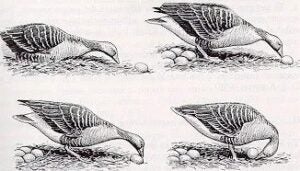
Konrad Lorenz identified Fixed Action Patterns as innate or instinctual behavior patterns that were species specific.
https://en.wikipedia.org/wiki/Fixed_action_pattern
In turn, Breland and Breland, students of B. F. Skinner, contributed their knowledge based on training hundreds of animals.
They attempted to bridge the gap between early psychologists’ view that the mind was a blank slate and the early ethologists that realized some behavior was hardwired. The most important concept was their notion of “instinctual drift”.
Now we can look at the work of Raymond and Lorna Coppinger, where they describe “behavioral conformation” and “Breed Typical Motor Patterns”.
https://www.amazon.com/gp/product/0226115631/ref=dbs_a_def_rwt_bibl_vppi_i0
Last consider the work of John Lighton who is studying Metabolic Phenotype and found that there are “Behavioral Circuits” or patterns of behavior that occur in certain sequences to promote other behaviors.
https://www.youtube.com/watch?v=fPu4K7ki7zM (especially from 24:45)
I apologize for such a lengthy introduction to an idea important to raising a successful detection dog. Your goal cannot be accomplished without the understanding of what your dog needs to achieve success. Too hungry, too sated, too tired, too energetic, too fat, too thin, too excited for reward, not motivated for reward, all these can be affecting the dog’s single session or the dog’s final outcome. These ideas are in line with the earlier post, 10 Behaviors of Expert Animal Trainers (Jan 30, 2019).
You are working to use the dog’s natural ability to accomplish a task. If you find yourself showing the dog how to do everything, you may be fighting against your very goal. Skinner may have believed that the mind was a blank slate ready for stimulus and response, but even his early students saw the limitations of such beliefs. Our dogs do not suffer from “instinctual drift” but have been artificially selected for specific genetic behavioral patterns.
A large government agency training dogs for detection work only recently “discovered” how much time they were wasting training pointers to sit instead of point as their final response on a target odor. It would seem so simple, yet it took years to understand the productive behavior pathway of the dog was easier than the artificial/unnecessary goal of the human trainer. Save yourself time! Work with the dog in front of you and with what it needs to express the behavior you are trying to help it build upon.

